Paslode F350-S User Manual

P
PNEUMATIC TOOLS
Operating and Maintenance Manual
403606-18- 08/07
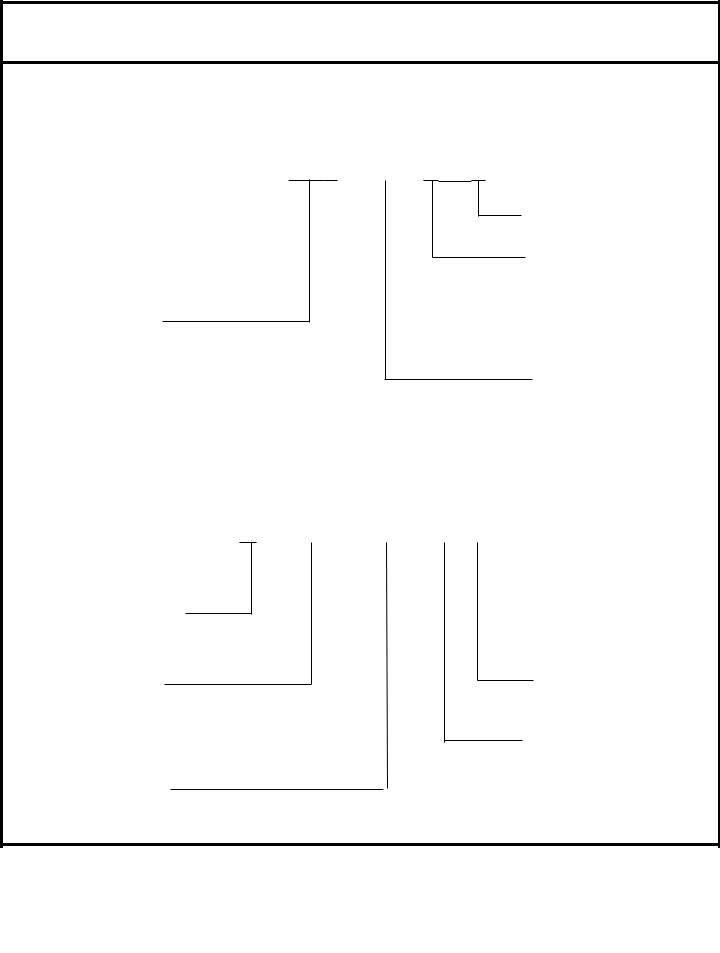
PASLODE MODEL NUMBER DESIGNATION
The model number of each Paslode tool contains information about the tool and the fasteners that are used with it. The following example illustrates the information contained in this tool model number.
NAILER |
O 000 / 00 C P |
Tool application letter 
Maximum fastener length, in inches that can be used with the tool
Power Pack
Type of tool
( C = coil nailer)
( S = strip nailer)
( F = finish nailer) ( R = Roof nailer)
Maximum fastener length in millimeters
STAPLER |
O 000 / 00 - S 00 P |
|||
|
|
|
|
|
Tool application letter
Maximum fastener length, in inches that can be used with the tool
Maximum fastener length in millimeters
Type of tool
( P= powerpack)
( DL= double length)
Gauge of fastener
Indicates crown size ( W = wide)
( S = standard)
( I = intermediate) ( N = narrow)
Paslode is a member of:
INTRODUCTION
Congratulations on purchasing a Paslode pnuematic tool. You have made a wise choice.
A Paslode tool is a professional quality tool that combines power and speed in a light weight design for versatile operation in a variety of industial and construction applications.
Please take the time to review this entire manual and all other documentation that came with the tool.
They will help you to become familiar with operating a power fastening tool. Be sure to read the safety instructions carefully before using your new tool. Also read Paslode's warranty statement in the back of this manual.
Even though Paslode ia a leader in the power fastening business, we continually strive to find new and better ways of improving our products. That is a commitment we've made to our most important asset: our customer.
Paslode also manufactures a line of cordless tools featuring Impulse Technology, which are not covered in this manual. For maintenance and safety information on the line of cordless tools, consult the operating manuals for those tools.
TABLE OF CONTENTS |
|
INTRODUCTION............................................................................................................... |
1 |
SAFETY INSTRUCTIONS................................................................................................ |
2 |
AIR SYSTEMS.................................................................................................................. |
3 |
TOOL INSTALLATION...................................................................................................... |
5 |
TOOL OPERATION.......................................................................................................... |
5 |
TOOL LOADING............................................................................................................... |
6 |
MAINTENANCE................................................................................................................ |
9 |
OPERATOR TROUBLESHOOTING................................................................................ |
12 |
TOOL WARRANTY................................................................................. |
Inside Back Cover |
1
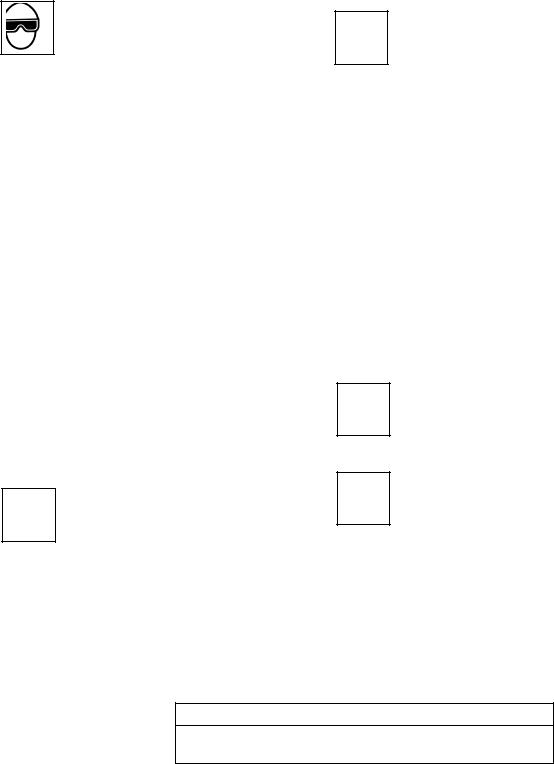
SAFETY INSTRUCTIONS
SAFETY FIRST
These safety instructions provide information necessary for safe operation of Paslode® tools. DO NOT ATTEMPT
TO OPERATE THE TOOL UNTIL YOU READ AND UNDERSTAND ALL SAFETY PRECAUTIONS AND MANUAL INSTRUCTIONS.
WEAR EYE AND HEARING PROTECTION
Always wear hearing and eye protection devices, that conform to ANZI Z87.1 requirements, when operating or working in the vicinity of a tool. As an employer you are responsible for enforcing the use of eye protection. Wear hard hats in environments that require their use.
THE TOOL MUST BE USED ONLY FOR THE PURPOSE FOR WHICH IT WAS DESIGNED
Do not throw the tool on the floor, strike the housing in any way or use the tool as a hammer to knock material into place.
NEVER ENGAGE IN HORSEPLAY WITH THE TOOL
The tool is not a toy so do not use it like one. Never engage in horseplay with the tool or point it at yourself or any other person, even if you think it is not loaded.
NEVER ASSUME THE TOOL IS EMPTY
Check the magazine for fasteners that may be left in the tool. Even if you think the tool is empty or disconnected, never point it at anyone or yourself. Unseen fasteners could fire from the tool.
NEVER CLAMP THE TRIGGER IN A LOCKED OR OPERATING POSITION
The trigger of the tool must never be tampered with, disabled or clamped in a locked or operating position since this will cause the tool to drive a fastener any time the work contacting element depressed.
DO NOT LOAD FASTENERS WITH THE AIR LINE CONNECTED, OR WITH THE TOOL TRIGGER OR WORK CONTACTING ELEMENT DEPRESSED
When loading fasteners into the tool be sure you disconnect the air line and that you do not depress the trigger or work contacting element.
OPERATE THE TOOL ONLY ON A WORKPIECE
The tool should be operated only when it is in contact with the workpiece. Even then you should be careful when fastening thin material or working near the edges and corners of the workpiece since the fasteners may drive through or away from the workpiece.
DO NOT DISABLE OR REMOVE THE WORK CONTACTING ELEMENT
This tool is equipped with a safety mechanism, called a work contacting element, to help prevent
accidental firing. Never tamper with, disable or remove the work contacting element. Do not use the tool unless the work contacting element is working properly. The tool could fire unexpectedly.
DISCONNECT THE TOOL WHEN NOT IN USE
Always disconnect the tool from the air line when it is not in use, when you leave the work area or when moving the tool to a new location. The tool must never be left unattended because people who are not familiar with the tool might handle it and injure themselves or others.
CARRY THE TOOL ONLY BY THE HANDLE
Always carry the tool by the handle only. Never carry the tool by the air hose or with the trigger depressed since you could drive a fastener unintentionally and injure yourself or someone else.
DO NOT WEAKEN THE TOOL HOUSING
The tool housing is a pressure vessel and should never be weakened by having your company’s name, area of work or anything else stamped or engraved into its surface.
DISCONNECT THE TOOL WHEN PERFORMING REPAIRS AND CLEARING JAMS
Never attempt to clear a jam or repair a tool unless you have disconnected the tool from the air line and removed all remaining fasteners from the tool.
ALWAYS USE THE PROPER FITTING FOR THE TOOL
Only MALE pneumatic type air connectors should be fitted to the tool, so that high pressure air in the tool is vented to atmosphere as soon as the air line is disconnected.
NEVER install FEMALE quick disconnect couplings on the tool. Female couplings will trap high pressure air in the tool when the air line is disconnected, leaving the tool charged and able to drive at least one fastener.
DO NOT EXCEEDTHE MAXIMUM RECOMMENDED AIR PRESSURE
Operate the tool only at the recommended air pressure. Do not exceed the maximum air pressure marked on the tool. Be sure the air pressure gauge is operating properly and check it at least twice a day.
Never use any bottled air or gases such as oxygen to operate the tool since they could cause the tool to explode.
INSPECT TOOL FOR PROPER OPERATION
Clean the tool at least daily and lubricate as required.
Never operate a dirty or malfunctioning tool.
USE ONLY PASLODE RECOMMENDED PARTS AND FASTENERS
Use only parts and fasteners specifically designed and recommended by Paslode for use in the tool and for work to be done. Using unauthorized parts and fasteners or modifying the tool in any way creates dangerous situations. Replace all missing warning labels---refer to tool schematic for correct placement and part number.
 WARNING
WARNING
Failure to follow any of the above instructions could result in severe personal injury to tool user and bystanders or cause damage to tool and property.
Contact your local Paslode Representative for presentation of Paslode’s Safety Awareness Program
2
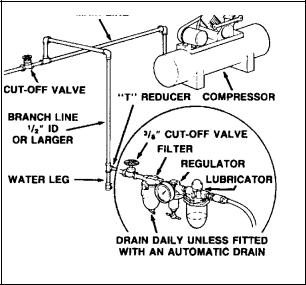
AIR SYSTEMS
For air-powered tools to work their best, the air supply system must be properly installed and maintained regularly. A drawing in this section shows a properly installed air supply system. Handy checklists for installing and maintaining air supply systems follow.
Indoor Air System Installation -Be certain that:
•All pipes supplying air have a large enough inside diameter to ensure adequate air supply.
•The main supply pipe slopes down, away from the compressor (1/16 inch per foot).
•Air storage is provided along lengthy air lines.
•Pipe line branch outlets are at the top of the main pipe line.
•Cutoff valves are provided at each branch pipe line throughout the system.
•Water legs extend from the bottom of each branch line.
•A refrigerant-type dryer is installed on the system.
•Air hoses are kept as short as practical.
•A regular maintenance program is followed.
Outdoor Air System Installation -Be certain that:
•A moisture trap and a filter/regulator/lubricator are installed at the compressor.
•Air hoses and fittings are large enough so that air flow is not restricted. Minimum hose size is 3/8 inch ID with 1/2 inch ID hose used for any application over 25 feet.
•Air hoses are not longer than 150 feet.
•The air system is lubricated regularly.
•A regular maintenance program is followed.
Filter/Regulator/Lubricator Units
Filter/regulator/lubricator units that can supply enough air and protection for Paslode tools must meet the following specifications:
•Minimum 3/8 inch NPT port size .
•50 micron or fine filters.
•Regulated pressure from zero to 120 psi.
•Lubricators designed for low or changing airflow.
3

AIR SYSTEMS - Continued
Calculating Compressor Size
Use the air consumption chart in the Tool Schematic for eaxh tool when calculating the operating requirements for the tools. Paslode tools are designed to operate efficiently between 80 and 120 psi and should never be operated at pressure greater than 120 psi. The air consumption chart will help you find the correct compressor size for your application that will quickly replenish tool air pressure.
To use the chart you will need to know how many tools will be used and approximately how many fasteners will be driven each minute by each tool onthe line. Using the equation:
Number of tools X average fasteners/minute/ tool X 1.2 (safety factor) X air consumption (scfm) @ pressure* (psi) = scfm required.
We can use the following example:
10 tools X 30 fasteners/minute/tool X 1.2 X 0.051scfm* (@100psi) = 18.36 scfm.
*This number is found in the Air Consumption Chart
In this example, using the air consumption chart wefind that a compressor providing at least 19 scfm of air is required. Because in compressors approximately 1 hp is required to produce 4 scfm, a compressor of at least 5 hp is required.
Calculated Required Piping
For example, given a 20 hp electric compressor supplying approximately 80 cfm of air at 120 psi and a main supply pipe length of 350 feet, we see by the table the minimum main pipe inside diameter required for this
application is 1-1/4 inch.
Pneumatic System Maintenance
-Be certain that:
•Pneumatic fittings are tight and do not leak.
•Water legs, filters and air lines are drained daily, and ensure that automatic draining systems are operating correctly.
•Air lines are cleared to prevent freezing, especially in winter.
•Lubricator operation is checked regularly and ensure it has an adequate supply of lubricant. (Paslode Part No. 403720)
•The filter element is cleaned every six months.
•Only regulated air is being used and that each regulator is operating properly.
4

TOOL INSTALLATION
Your Paslode tool comes ready for immediate use and can be installed by following these steps:
1.SAFETY - All tool operators and their immediate supervisors must become familiar with the operator safety instructions before operating the tool. The instructions are on page 2 of this manual.
2.Included wuth each tool are one copy of this Safety and Maintenance manual and one copy of the Tool Schematic. Keep these publications for future reference. An ownership registration card is also included. This card must be completed and returned to Paslode immediately to register your ownership.
3.The plastic cap in the air inlet of the tool must be removed before the male fitting is installed. The fitting must be a male pneumatic type that discharges the air from the tool when the air line is disconnected.
4.Install a filter/regulator/lubricator unit, with a gauge as close as practical to the tool, preferably within ten feet. Refer to the Air Systems section of this manual for air hose requirements and lengths. In general, no other special installation is required.
5.If the operator is working at a bench or table,
it is usually best to run the air line underneath the bench. A small tray under the benchtop can hold the fastener supply and the tool when not in use.
6. If this tool does not work when it is first connected, do not try to make repairs. Call your Paslode representative immediately.
TOOL OPERATION
Depth of Drive Adjustment
(On tools equipped with this feature)
The depth of drive adjustment is made by adjusting the work contacting element. The lock nut is loosened to allow the element to be moved up or down. You will need a 3/8 inch open end or 5/32 inch hex socket wrench to make this adjustment.
If the tool is overdriving (the fastener head or crown is driven below the work surface), the work contacting element should be moved downward. If the fasteners stand up (the head or crown is not flush with the surface), the work contacting element should be moved up.
Adjust the work contacting element until the fastener head or crown depth meets job requirements.
LOCK |
MOVE UP |
|
||
NUT |
||||
|
||||
TO INCREASE |
|
|||
|
|
|||
|
DRIVE DEPTH |
|
|
|
WORK |
|
|
|
|
CONTACTING |
|
|
|
|
ELEMENT |
MOVE DOWN |
|
|
|
|
TO INCREASE |
|||
DRIVE DEPTH
5
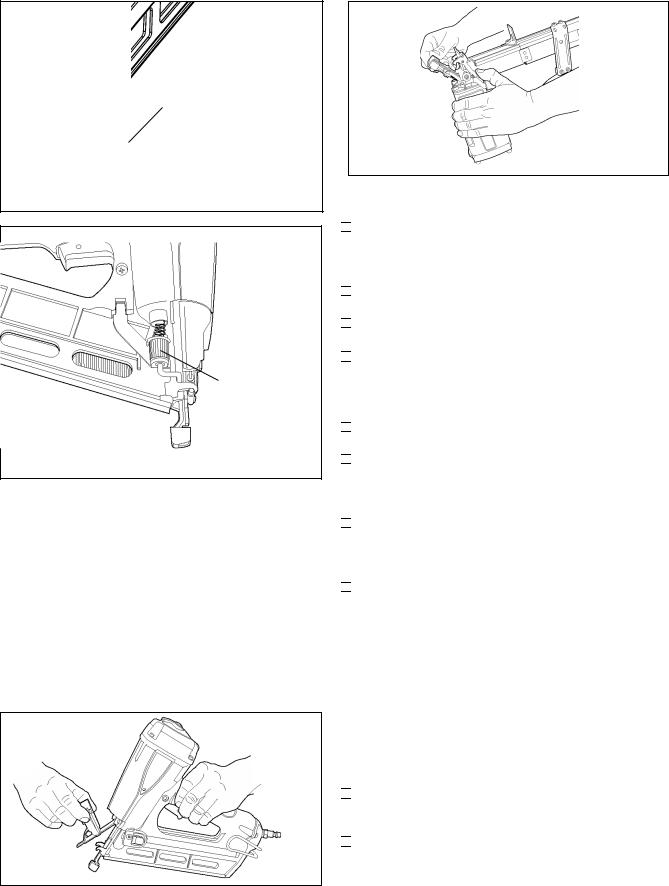
TOOL OPERATION - continued
MOVE UP
TO INCREASE
DRIVE DEPTH
MOVE DOWN
TO DECREASE
DRIVE DEPTH
SOCKET HEAD
CAPSCREW  WORK CONTACTING ELEMENT
WORK CONTACTING ELEMENT
Turn adjustment wheel in either direction
Clearing a Jam
An occasional problem you may encounter is a jammed fastener. Because of the unique design of the tool, clearing a jammed fastener is easy:
1.Disconnect the air supply.
2.Pull the latch, releasing front guide. Pivot front guide forward.
3.Clear jam, and push driver blade back up to its normal position.
4.Close front guide and latch it. Check that
work contacting element moves freely.
clearing a jam continued
Precision Placement Driving - (Orange Trigger)
■
 Grasp the tool handle firmly and hold the bottom of the work contacting element firmly against the workpiece until it is completely depressed.
Grasp the tool handle firmly and hold the bottom of the work contacting element firmly against the workpiece until it is completely depressed.
■
 Squeeze the trigger to drive the fastener.
Squeeze the trigger to drive the fastener.
■
 Lift the tool from the workpiece.
Lift the tool from the workpiece.
■
 Repeat the procedure for the next fastener.
Repeat the procedure for the next fastener.
Successive (Bounce) Driving - (Orange Trigger)
■
 Grasp the handle firmly.
Grasp the handle firmly.
■
 Squeeze the trigger and move the tool along the workpiece with a bouncing motion, depressing the work contacting element at the points where you want to insert a fastener.
Squeeze the trigger and move the tool along the workpiece with a bouncing motion, depressing the work contacting element at the points where you want to insert a fastener.
■
 Keep the trigger depressed and continue to bounce the work contacing element against the workpiece, positioning the tool above as carefully as possible.
Keep the trigger depressed and continue to bounce the work contacing element against the workpiece, positioning the tool above as carefully as possible.
■
 When the desired number of fasteners have been driven, release the tool trigger to avoid unintentional fastener discharge.
When the desired number of fasteners have been driven, release the tool trigger to avoid unintentional fastener discharge.
Sequential Operation - (Silver Trigger)
The sequential operating kit prevents succesive or "bounce" driving.
■
 Depress the work contacting element and hold it against the work surface before pulling the trigger.
Depress the work contacting element and hold it against the work surface before pulling the trigger.
■
 After each fastener is driven, completely release the trigger and lift the tool from the work surface.
After each fastener is driven, completely release the trigger and lift the tool from the work surface.
6

TOOL LOADING
Coil Nailers
Step No. 1 – Grasp the nailer handle firmly with one hand and with the other hand unlatch the magazine cover clip. Swing the magazine door open.
Step No. 2 – Adjust the loading tray for nail length (if required) by depressing the button on the post and raising or lowering the tray to the desired position.
Step No. 3 – Remove the retainer from a nail coil and place the nail coil in the magazine with the tips of the nails against the loading tray and with about 4 inches of coil unwound
Step No. 4 - Slide the free strip of nails along the top of the feeder body assembly and place the first nail between the feed claw and the locator.
Step No. 5 - Carefully close and latch the magazine door.
Step No. 6 - Advance the first nail into driving position by cycling the tool once against a work surface. The nailer is
7 now ready for use.
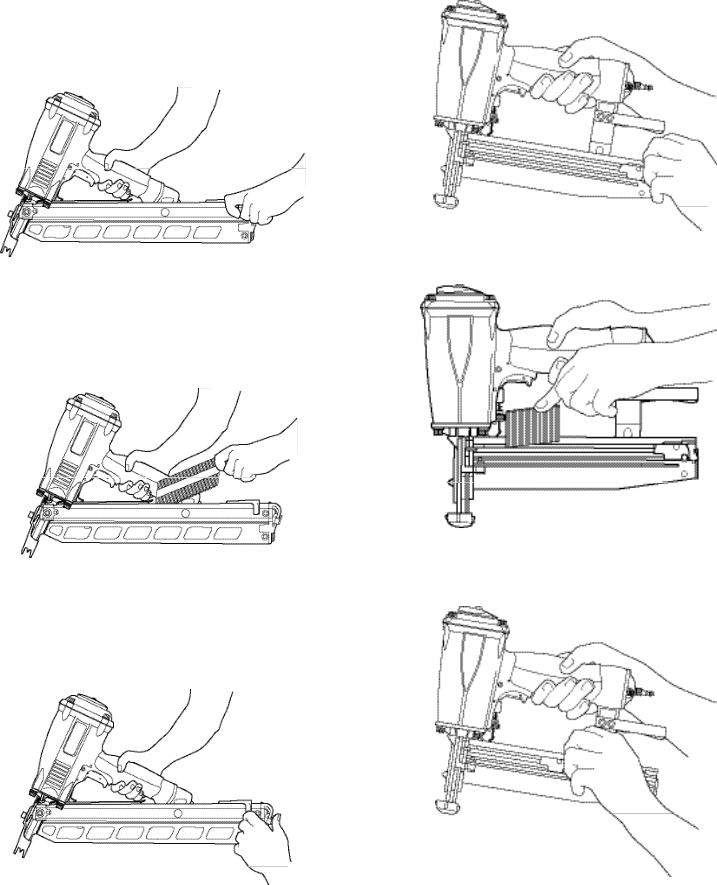
RHP-350
PowerMaster Plus
Strip Nailers
Step No. 1 – Grasp the nailer handle firmly. Pull the magazine follower all the way to the rear of the magazine until it is latched into its loading position by the magazine latch.
Step No. 2 – Insert the a strip of fasteners into the top of the magazine with the point of the nails facing the nose area.
Step No. 3 – Hold the follower firmly and press the follower latch. Slide the follower forward until it
contacts the nails.
T250-F16 Series Finish Nailer
Step No. 1 – Grasp the nailer firmly with one hand.
Step No. 2 – Insert the strip with the point of the fastener facing down towards the bottom of the magazine.
Step No. 3 – Hold the follower firmly and press the follower latch. Slide the follower forward until it contacts the nails. The tool is now ready for use.
8
